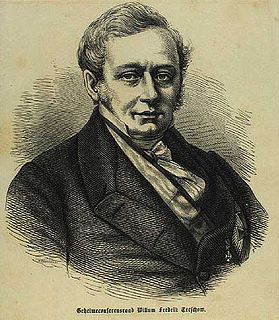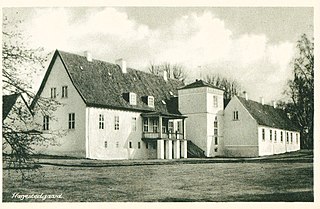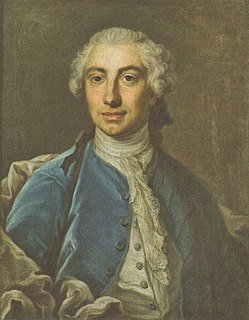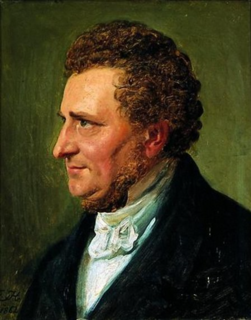
Holbæk is a town in Denmark and the seat of Holbæk municipality with a population of 28,833. It is located in the northeastern part of Region Sjælland, Denmark.

Christen Andreas Fonnesbech was a Danish lawyer, landowner and politician. He was Council President of Denmark from 1874 to 1875.

Nicolai Wergeland was a Norwegian priest, writer and politician, and a member of the Norwegian Constituent Assembly at Eidsvoll that wrote the Constitution of Norway on 17 May 1814. He was elected as one of two delegates from Christianssand to the Eidsvoll Assembly in 1814. He represented the unionist side, and came very well prepared to Eidsvoll, bringing his own constitution draft. Along with him from Christiansand came wholesaler Ole Clausen Mørch.

Jacob Peter Mynster was a Danish theologian and clergy member of the Church of Denmark. He served as Bishop of the Diocese of Zealand from 1834 until his death.
Ludvig Stoud Platou was a Danish-Norwegian educator, historical and geographical writer, politician and State Secretary.

Eriksholm Castle is a manor house located at the foot of the Isefjord inlet, 6 km south-east of Holbæk, in east Denmark. The history of the estate dates back to 1400 but today's house was built in 1788. It was designed by Caspar Frederik Harsdorff, the leading Danish architect of the time.
Bredo Otto Anton von Munthe af Morgenstierne was a Danish historian of nobility and history of architecture.

Vilhelm Frederik Treschow (15 September 1786 – 2 April 1869 was a Danish supreme court attorney, politician, landowner and philanthropist. He founded Treschows Stiftelse in Copenhagen.
The Seidelin family is a Danish family descending from bailiff and councilman in Helsingør Michel Seidel. He was originally from Werder in Pomerania or East Prussia and purchased a house in the city in 1589. Nothing else is known about his background. The name Seidelin was passed on through his daughters who in accordance with German tradition added the suffix -in to their father's name.

Hans Diderik de Brinck-Seidelin was a Danish Supreme Court justice and landowner who was raised to the peerage under the name Brinck-Seidelin in 1753. He owned the estates Hagestedgård (1748-1769), Holbæk Ladegård (1748-1778) and Eriksholm (1762-1778).

Hans Seidelin was a Danish civil servant and landowner who was raised to peerage in 1731. He was district governor of Copenhagen County from 1724 to 1730 and later served as Post Master General of Royal Danish Mail.

Hagestedgaard is a manor house and estate located at the village of Hagested, near Holbæk, Holbæk Municipality, some 60 kilometres west of Copenhagen, Denmark. The estate traces its history back to the 13th century but the current asymmetrical complex of single-storey, white-washed buildings surrounding a central courtyard was constructed for Hans Didrik Brinck-Seidelin in 1747 with the exception of the remains of a tower built by Johan Friis in 1555. The estate has been owned by members of the Castenskiold family since 1769.

Holbæk Ladegård is a former manor house at Holbæk, Denmark. It is now home to Kunsthøjskolen, a folk high school specializing in art programmes. Holbæk Ladegård was for centuries a home farm under Holbæk Castle, which was built to protect Holbæk and was held in fee by royal vassals.

Johan Caspar Mylius was a Danish military officer and landowner. He was appointed as chamberlain in 1840 and ennobled under the name de Mylius on 14 October 1840.

Jens Krag-Juel-Vind, Baron of Juellinge, was a Danish nobleman, Supreme Court justice and landowner.

Martin Johannes Hammerich was a Danish art historian, educator, author and translator. He was part of the National Liberal movement and a member of the 1848 Danish Constituent Assembly. He was headmaster of Borgerdydskolerne from 1842 to 1867.

The Danish Constituent Assembly is the name given to the 1848 Constitional assembly at Christiansborg Palace in Copenhagen, that voted the Danish Constitution and formalized the transition from absolute monarchy to constitutional democracy. It consisted of members of which 114 were elected by the people, 38 were appointed by the king and the rest were government ministers.

Peder Brønnum Scavenius was a Danish landowner and politician. He was the owner of Gjorslev on the Stevns Peninsula, Klintholm on Møn and Petersgaard at Vordingborg. He was an also involved in politics and by royal appointment a member of the Danish Constituent Assembly.

Hegnsholt is a country house an estate located at Grønholt, between Fredensborg and Hillerød, North Zealand, some 40 km north of Copenhagen, Denmark. The first main building on the estate was built in 1815 to designs by Christian Frederik Hansen but it was extended in 1904 and adapted by the architect Louis Hygom in 1920 for the businessman William Bendix. The estate is now owned by Cabinn Hotels-owner Niels Fennet. The adjacent Grønholt Airfield was built on part of the land in 1940.
Jens Juel was a Danish estate owner, chamberlain and Member of the Royal Hunt. He was from 1938 the owner of Petersgaard at Vordingborg, including the vast Pedersgaard Forrest District. He was a board member of the Danish Forrest Association (1959–65). He served as director both of Den Suhrske Stiftelse (1940–1962) and of Det Classenske Fideicommis (1948–74).
















